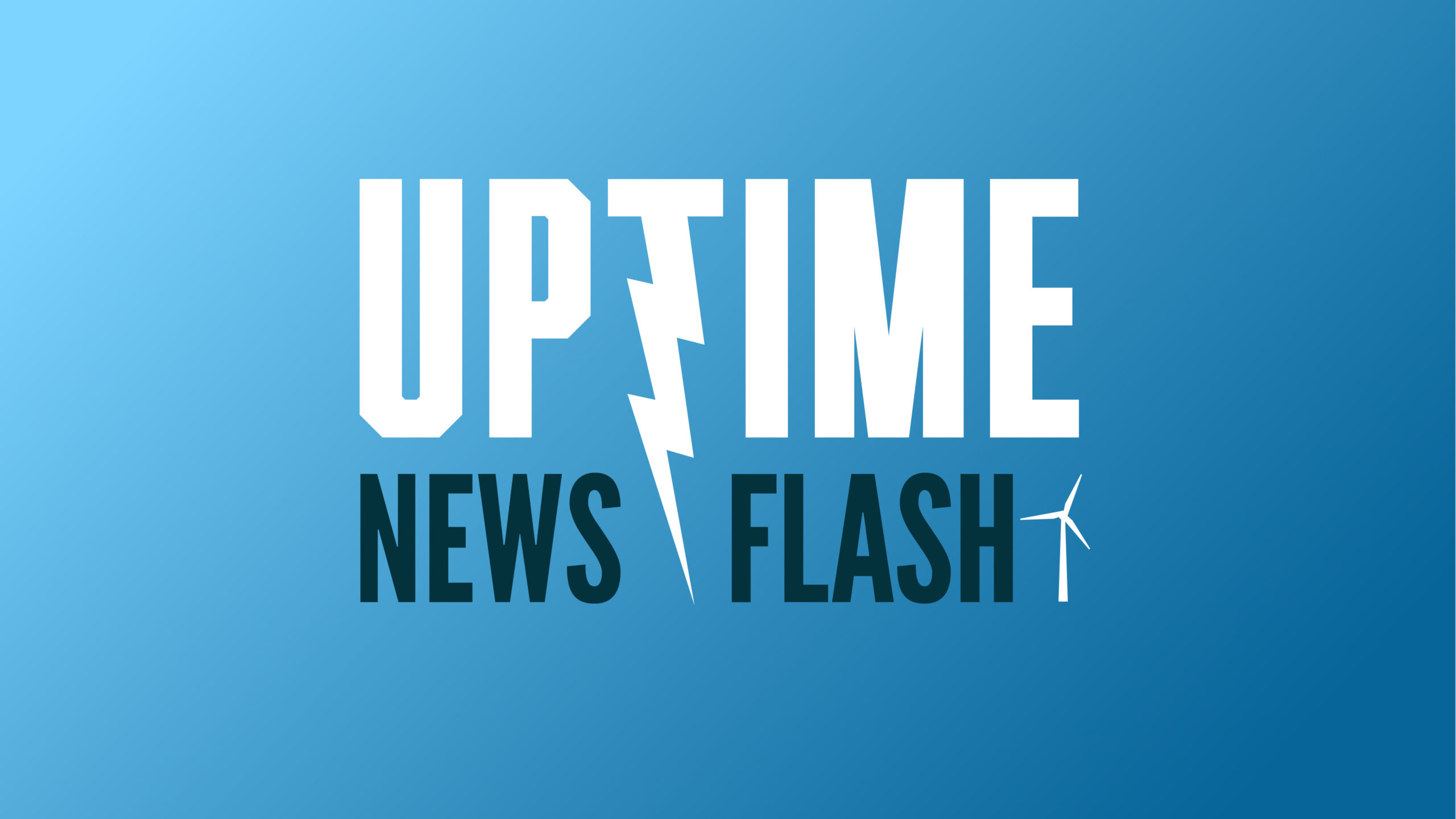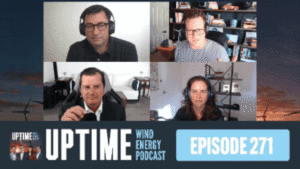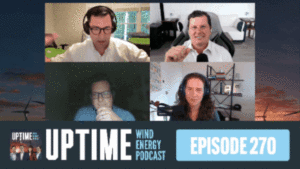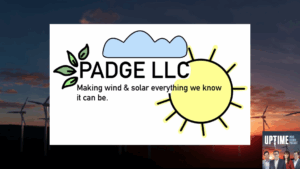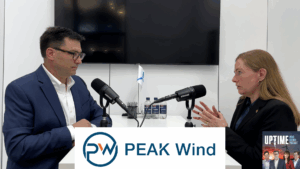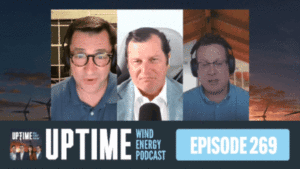Podcast: Play in new window | Download
This week we discuss GE Vernova’s $600 million investment in its US facilities, ORIX selling its stake in Greenko to AM Green Power, and a 70 GW wind and solar project in Western Australia seeks federal approval.
Fill out our Uptime listener survey and enter to win an Uptime mug! Register for Wind Energy O&M Australia! https://www.windaustralia.com
Sign up now for Uptime Tech News, our weekly email update on all things wind technology. This episode is sponsored by Weather Guard Lightning Tech. Learn more about Weather Guard’s StrikeTape Wind Turbine LPS retrofit. Follow the show on Facebook, YouTube, Twitter, Linkedin and visit Weather Guard on the web. And subscribe to Rosemary Barnes’ YouTube channel here. Have a question we can answer on the show? Email us!
Welcome to Uptime News Flash. Industry news, lightning fast. Your hosts, Allen Hall, Joel Saxum, and Phil Totaro, discuss the latest deals, mergers, and alliances that will shape the future of wind power. News Flash is brought to you by IntelStor. For market intelligence that generates revenue, visit www.intelstor.com.
Allen Hall: So this week, Phil, a number of really interesting moves in renewable energy. First off is the Western Green Energy Hub has submitted its proposal for federal environmental approval in Western Australia, someplace we’re going to be pretty soon. The project plans to install 70 gigawatts of wind and solar capacity through 35 power nodes.
Now, each node will include 2 to 3 gigawatts of generation and about 1. 5 gigawatts of electrolyzer. Phil, Western Australia has a number of renewable projects planned. What makes this one unique? Well,
Phil Totaro: it’s the first one. They’re
Allen Hall: going to
Phil Totaro: do it. Yeah. Because of all these mega projects that have been proposed throughout Australia.
There’s some in Queensland and South Australia, and I think one in Victoria as well. And what we’re talking about is something that’s like, 30, 40, 50, 60, in this case, 70 gigawatts worth of generation capacity. That’s almost. I mean, 70 gigawatts is almost what the entire Australian grid produces on an annual basis.
So what they’re doing with this is they’re saying, all right, it’s going to accommodate some, increased electricity demand. Although the, the amount that, that it’s going to increase is, is modest compared to the, the amount they’re going to be generating. But as you mentioned, they’re going to add all these, um, Electrolyzer is to be able to produce hydrogen on a lot of these mega projects in Australia that have been proposed.
That’s their intent is to, build these these things with, turbines that are going to be at least 10. Megawatts each, if not bigger. The reality with this is it is the first of these kind of mega projects to, to get into this environmental permitting and consent queue. And so this is the start of what could be, a pretty major undertaking.
Joel Saxum: Something to think about here too, is this is in Western Australia. So if you know anything about Western or if you know anything about Australia’s grid, it’s not very well connected East to West. And the major demand centers are all in the East. You have Perth in the West, of course, but that Western side of Australia, the grid doesn’t need much energy to support it.
It doesn’t have a whole lot of demand compared to the rest of the, or the, to the Eastern parts of the country. So at the end of the day, 70 gigawatts is great, but the This is going to be just a, not just, but for the most part, a green hydrogen project, right? They don’t need 70 gigawatts of clean energy to fulfill the grid needs over there.
That doesn’t demand that much. So most of this energy was used for hydrogen, green hydrogen creation. And that’s one thing that Australia does really, really, really well. They have a lot of natural resources and they know how to export. So you, you look to see this project. Project creating a green energy hub and a green energy powerhouse or green hydrogen powerhouse out of the country of Australia.
And now you just got to find offtake.
Allen Hall: Right, Phil. Where is this green hydrogen headed to?
Phil Totaro: We’ll see, because they actually don’t, that’s one of the challenges for this project commercially, is they don’t necessarily have the, the full demand fulfillment. They will probably send some of it to well, actually, they might send some of it to China.
They’ve been talking about exporting some hydrogen to some of the other Southeast Asian countries that are their, their kind of most adjacent neighbors. But that’s actually an important consideration that I don’t think they’ve fully addressed yet.
Allen Hall: Next up, ORIX Corporation is selling its 20 percent stake in GreenCo Energy Holdings to AM Green Power BV for 1.46 Billion U. S. dollars. The Japanese company will also invest in convertible notes issued by AM Green Luxembourg, the parent company. Now, Greenco Energy operates about seven and a half gigawatts of renewable energy capacity, including solar, wind, and hydropower projects, and is developing large scale pump storage power facilities.
All right, Phil, again, another huge financial transaction here involving a Japanese company. Obviously Japan is heavily involved in things like in the UK at the minute, offshore, floating wind. There’s a lot of activity going around there. What is the activity behind this acquisition?
Phil Totaro: Yeah, well, for those that aren’t familiar, ORIX actually also owns El Juan Energy which is big renewable energy project developer in, in Europe, Spain in particular.
The reason that ORIX got into both of these companies El Juan and now that they’re divesting GreenCo they, they wanted to, to plow some money behind renewable energy projects. But the fact that they’re taking this portfolio projects that Greenco has and selling it off for a rather stout amount of money, I have to say is, reflective of the fact that they think they can cash out.
on something that’s kind of, in, in high demand, which are assets in India that are operational or potentially in need of repowering because they’re starting to get their act together over there and getting a policy framework in place in each one of the states in India to, to actually get repowering projects undertaken.
Great acquisition and good deal on, on behalf of ORIX. They remain invested at this point in Elowan Energy. And ORIX, may end up redeploying their capital, the 1. 46 billion in. Other renewable energy investments as, as they decide to move forward.
Joel Saxum: I think that’s the interesting thing here, Phil, exactly like you said, what’s OREC’s going to do next?
Because, none of us are flies on the walls in these, in these conference rooms or in these strategy rooms behind, what’s an evergreen investment, which kind of investment has an end date on it. What are we trying to do for a structure here within our investment vehicle? We don’t know what that is.
So there may have just been a date where OREC said, Hey. Beginning of 2025, we’re going to sell this thing no matter what, and either, I’m not saying that’s what happened, but that could be what happened. Either way, ORIX is sitting, going to be sitting on a pile of cash come March and it would be really interesting to see what they do with it.
Allen Hall: They don’t have a pile of debt that they’re paying off, Phil, do they?
Joel Saxum: No.
Phil Totaro: They do not.
Allen Hall: Okay. So this is, so this is a pure acquisition, moving cash around, finding more active markets for their deployable capital.
Phil Totaro: Yes, and keep in mind too that they could be waiting for, making additional investments in Europe or the US.
Or, I mean, they could go down into Brazil or who knows where with, with their next move. That’s the one advantage of having the pile of cash is that even in a high interest rate environment, you have choices as far as where you want to deploy capital. And, You’ll be able to selectively pick markets for either a strategic investment in a local developer or potentially acquiring a portfolio that, that might be available or building new greenfield.
So there’s, there’s a lot of strategy options on the table for them to be able to move forward. So would you say
Joel Saxum: they’re sitting in the conference room right now, looking to see what country has the best political framework to invest in?
Phil Totaro: Well, and not for nothing, but countries that are not the United States at the moment have gotten the message of, hey, we need to make ourselves look a lot more attractive to get more foreign direct investment
Allen Hall: at this point.
Speaking of investment, GE Vernova will invest 600 million in its U. S. facilities over two years, creating about 1, 500 jobs. Now, this plan includes 300 million for its gas power operations, with about 160 million going. to their Greenville, South Carolina facility. The company will invest about 50 million for nuclear operations in Wilmington, North Carolina, which is a beautiful place, by the way, 100 million for wind manufacturing facilities and another 100 million for their advanced research center near me in New York.
Now, the investments are part of a larger 9 billion global investment plan through 2028. So, Phil, some of the money that has come into Vernova particularly for some AI gas powered turbine projects is going to be reinvested into the company and to stabilize different parts of it and try to improve efficiencies.
It sounds like where they’re going. Is that going to have an immediate return on investments? Like, are we expecting the stock price to bump up on this or is this more a longer term play to stabilize the company and make it profitable in 2028, 2030?
Phil Totaro: Yeah, it’s actually, that’s a really great question because they’re.
likely to make investments now that are, are they’re probably hoping are going to pay off in a number of years here. The last time they made these kind of investments was in 2004. In a lot of the facilities that they had. And what happened in 2004 was there was a gas turbine glut and prices dropped.
tanked, and everybody was, couldn’t sell a gas turbine to save their life. And what happens in that kind of a market environment, which we’re even, you could argue in, is happening for us in wind and, and a bit in renewables at the moment. is when the, the market environment is not currently attractive for making sales, that’s when you want to invest in your manufacturing facilities and capacity so that you’re ready when you do get orders so that you can immediately respond and, and not have a huge order backlog and an order backlog.
book. They are, as you said, spending, upwards of, a hundred million plus in some facilities to, to modernize and to ensure that they can meet the current, but more importantly, the future demand that they’re expecting.
Joel Saxum: As we say this, I’m taking a peek at the stock ticker and it looks like, because this announcement was earlier today, it looks like after hours trading has a stock up about 2%.
So that’s a good sign, but Alan, I want to ask you a question because this is something that’s near and dear to us is from the Uptime podcast and all of the people we talked to in the industry. Of course, G. E. Vernova a pylon in this industry that we’re all looking towards, but we’ve heard a lot of layoffs.
A lot of jobs have been lost. A lot of engineers by the wayside, a lot of people in the manufacturing facilities. And this announcement says we’re creating 1500 new jobs. Is one of GE’s strategies, or something they’ve done in the past from your knowledge bring these old emplo these, these laid off employees back?
Are those people going to get jobs back? Are they going to get offers? Or are they going to go to the new market for it?
Allen Hall: The more recent layoffs have let go of a number of really valuable people. And if you look at the names on LinkedIn, you see people that will easily find jobs across the industry because they’re just high quality people.
It’ll be very difficult for GE to run over to bring them back. I think whether Talking about as sort of more manufacturing level workers to build more products, not on the engineering side so much. So although this is interesting and it is good that GE Vernova is going to bring people back in terms of employment numbers are going to bump up a little bit.
I think they lost a huge number of really critical people. So it will be a challenge over the next couple of years to keep up with the demand they’re about to have.



